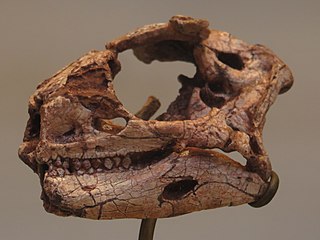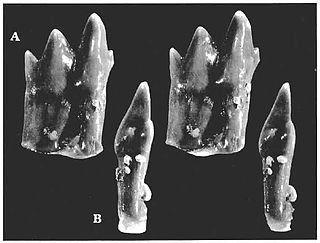
Allosaurus is a genus of carnivorous theropod dinosaur that lived 155 to 145 million years ago during the late Jurassic period. The name "Allosaurus" means "different lizard" alluding to its unique concave vertebrae. It is derived from the Greek ἄλλος and σαῦρος. The first fossil remains that could definitively be ascribed to this genus were described in 1877 by paleontologist Othniel Charles Marsh. As one of the first well-known theropod dinosaurs, it has long attracted attention outside of paleontological circles.

Lesothosaurus is a genus of omnivorous genasaurian dinosaur that lived during the Early Jurassic in what is now South Africa and Lesotho. It was named by paleontologist Peter Galton in 1978, the name meaning "lizard from Lesotho". The genus has only one valid species, Lesothosaurus diagnosticus.

Ceratosaurus was a carnivorous theropod dinosaur in the Late Jurassic period. This genus was first described in 1884 by American paleontologist Othniel Charles Marsh based on a nearly complete skeleton discovered in Garden Park, Colorado, in rocks belonging to the Morrison Formation. The type species is Ceratosaurus nasicornis.

The Morrison Formation is a distinctive sequence of Upper Jurassic sedimentary rock found in the western United States which has been the most fertile source of dinosaur fossils in North America. It is composed of mudstone, sandstone, siltstone, and limestone and is light gray, greenish gray, or red. Most of the fossils occur in the green siltstone beds and lower sandstones, relics of the rivers and floodplains of the Jurassic period.

Torvosaurus is a genus of carnivorous megalosaurid theropod dinosaur that lived approximately 165 to 148 million years ago during the late Middle and Late Jurassic Period in what is now Colorado, Portugal, and Germany. It contains two currently recognized species, Torvosaurus tanneri and Torvosaurus gurneyi.

Dryosaurus is a genus of an ornithopod dinosaur that lived in the Late Jurassic period. It was an iguanodont. Fossils have been found in the western United States and were first discovered in the late 19th century. Valdosaurus canaliculatus and Dysalotosaurus lettowvorbecki were both formerly considered to represent species of Dryosaurus.

Yangchuanosaurus is an extinct genus of metriacanthosaurid theropod dinosaur that lived in China from the Middle to Late Jurassic periods, and was similar in size and appearance to its North American and European relative, Allosaurus. Yangchuanosaurus hails from the Upper Shaximiao Formation and was the largest predator in a landscape that included the sauropods Mamenchisaurus and Omeisaurus and the stegosaurs Chialingosaurus, Tuojiangosaurus and Chungkingosaurus. This theropod was named after the area in which was discovered, Yongchuan, in China.
Oligokyphus is an extinct genus of advanced herbivorous cynodonts of the late Triassic to early Jurassic periods. Originally considered to be an early mammal, it is now classified as a Mammaliamorph because Oligokyphus does not have the mammalian jaw attachments and it retains a vestigial joint between the quadrate bone and the squamosal bone in the skull.

Tritylodon is an extinct genus of tritylodonts, one of the most advanced group of cynodont therapsids. They lived in the Early Jurassic and possibly Late Triassic periods along with dinosaurs. They also shared many characteristics with mammals, and were once considered mammals because of overall skeleton construction. That was changed due to them retaining the vestigial reptilian jawbones and a different skull structure. Tritylodons are now regarded as non-mammalian synapsids.

Neosodon was a genus of sauropod dinosaur from the Late Tithonian-age Upper Jurassic Sables et Gres a Trigonia gibbosa of Départment du Pas-de-Calais, France. It has never been formally given a species name, but is often seen as N. praecursor, which actually comes from a different animal. Often in the past, it had been assigned to the wastebasket taxon Pelorosaurus, but restudy has suggested that it could be related to Turiasaurus, a roughly-contemporaneous giant Spanish sauropod. It is only known from six teeth.

Dromaeosauroides is a genus of dromaeosaurid theropod dinosaur from the Early Cretaceous of what is now Denmark. It was discovered in the Jydegaard Formation in the Robbedale valley, on the island of Bornholm in the Baltic Sea. This is the only likely place for dinosaur remains to be discovered on Danish territory, since the Mesozoic deposits exposed in the rest of the country are marine. Dromaeosauroides is the first known dinosaur from this location, and the only one which has been scientifically named. It is one of the oldest known dromaeosaurs in the world, and the first known uncontested dromaeosaur from the Early Cretaceous of Europe.

Tanycolagreus is a genus of coelurosaurian theropod from the Late Jurassic of North America.

Terrestrisuchus is an extinct genus of very small early crocodylomorph that was about 76 centimetres (30 in) long. Fossils have been found in Wales and Southern England and date from near the very end of the Late Triassic during the Rhaetian, and it is known by type and only known species T. gracilis. Terrestrisuchus was a long-legged, active predator that lived entirely on land, unlike modern crocodilians. It inhabited a chain of tropical, low-lying islands that made up southern Britain, along with similarly small-sized dinosaurs and abundant rhynchocephalians. Numerous fossils of Terrestrisuchus are known from fissures in limestone karst which made up the islands it lived on, which formed caverns and sinkholes that preserved the remains of Terrestrisuchus and other island-living reptiles.

Ceratosauridae is a family of theropod dinosaurs belonging to the infraorder Ceratosauria. The family's type genus, Ceratosaurus, was first found in Jurassic rocks from North America. Ceratosauridae is made up of the genera Ceratosaurus, found in North America, Tanzania, and Portugal, and Genyodectes, from the Early Cretaceous of Argentina. Unnamed probable ceratosaurids are known from limited material in the Middle Jurassic of Madagascar, the Late Jurassic of Switzerland, and the Late Jurassic or possibly Early Cretaceous of Uruguay.

Camarasauridae is a family of neosauropod dinosaurs within the clade Macronaria, the sister group to Titanosauriformes. Among sauropods, camarasaurids are small to medium-sized, with relatively short necks. They are visually identifiable by a short skull with large nares, and broad, spatulate teeth filling a thick jaw. Based on cervical vertebrae and cervical rib biomechanics, camarasaurids most likely moved their necks in a vertical, rather than horizontal, sweeping motion, in contrast to most diplodocids. Cladistically, they are defined to be all sauropods more closely related to Camarasaurus supremus than to Saltasaurus loricatus.

Pantydraco was a genus of basal sauropodomorph dinosaur from the Late Triassic of the United Kingdom. It is based on a partial juvenile skeleton once thought to belong to Thecodontosaurus. Only one valid species of Pantydraco is recognised: P. caducus.

Dilophosauridae is a family of medium to large sized theropod dinosaurs. The name Dilophosauridae is derived from Greek, with “di-” meaning “two,” “lophos” meaning “crest,” “sauros” meaning “lizard,” and “-idae” meaning “family”. While the name suggests that all dilophosaurids have two crests, this is not applicable to all dilophosaurids. The Dilophosauridae is anchored by its type genus, Dilophosaurus, and therefore the name comes from the distinctive two crests of the genus.

The Qigu Formation is a Late Jurassic (Oxfordian) geologic formation in the Southern Junggar Basin in China. Indeterminate Dinosaur remains are among the fossils that have been recovered from the formation, including theropod teeth and a fibula. a stegosaur dorsal vertebra and a Eusauropod tooth. Xinjiangtitan was erroneously thought to be from this formation, but it is actually from the older Qiketai Formation, which is in a different basin. The term "Qigu Formation" is also used to sediments of equivalent age in the Turpan Basin, but this might better be treated as a separate formation. It is laterally equivalent to the Shishugou Formation.

Dyskritodon is a genus of extinct mammal from the Early Cretaceous of Morocco, and possibly the Early Jurassic of India. Of uncertain affinities, it is tentatively described as a eutriconodont.
The Mother’s Day Quarry (MDQ) is a Late Jurassic (Kimmeridgian) fossil site in the Morrison Formation that is located at the base of the Pryor Mountains in Carbon County, Montana. The site was first discovered by the Museum of the Rockies in 1994 and has produced over 2,500 elements since its discovery. Apart from approximately 12 theropod teeth, stegosaur limb material, and two conchostracans found at the site, these elements almost exclusively belong to specimens of the sauropod dinosaur Diplodocus sp. This deposit of fossils is thought to be the result of an age-segregated herd of these dinosaurs congregating at a limited water source and eventually succumbing to drought conditions.
























